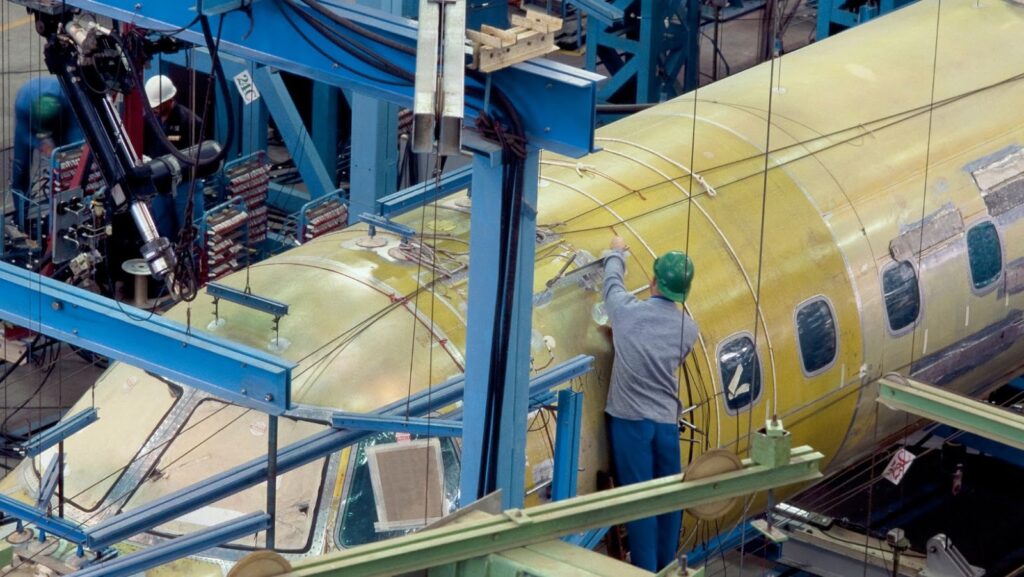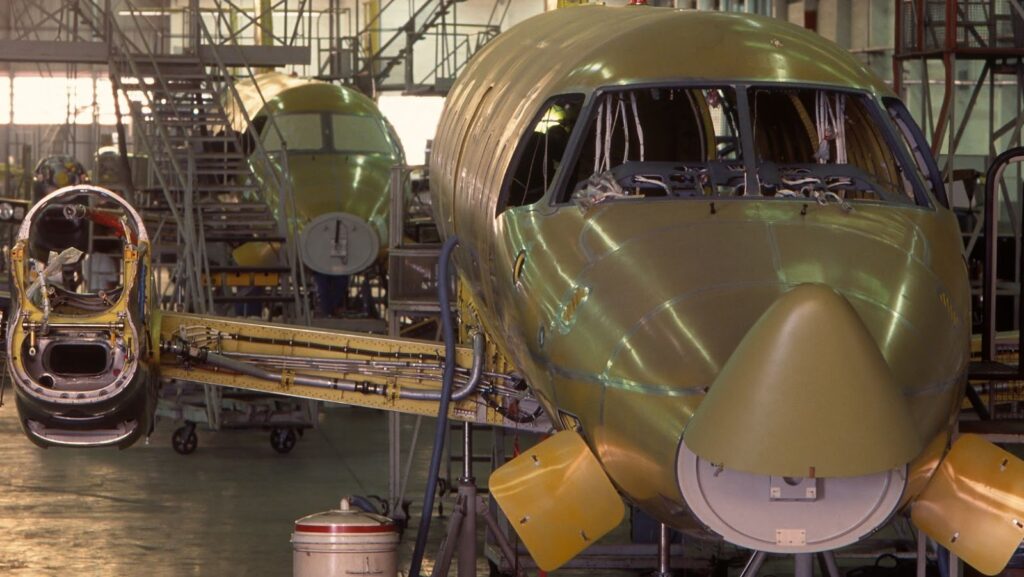Hadrian, a machine-parts start-up, recently raised $90 million to disrupt the aerospace supply chain. With the additional funds, Hadrian aims to develop technology to revolutionise how aerospace parts and components are sourced, produced, and delivered.
The aerospace industry currently relies on a strict supply chain system that is often inefficient and expensive. Let’s look at the problems with the aerospace supply chain and how Hadrian’s automated platform could be the answer.
Overview of the Aerospace Supply Chain
The aerospace supply chain is an intricate and complex network of activities necessary to ensure an efficient, cost-effective delivery of goods and services. It encompasses moving parts, materials and components to manufacturing sites; distributing finished products; post-production support activities; and many other related services.
Though the aerospace industry has been historically successful in increasing productivity and lowering costs due to technological advancements, it still faces many challenges that must be addressed. A few common problems include:
- Long lead times in product development.
- A lack of visibility into supplier performance.
- Inadequate control over materials planning processes.
- Poor knowledge sharing practices.
- Increasing global competition and more.
Moreover, the impact of digital transformation in the aerospace supply chain is far-reaching as organisations must continue to evolve from traditional methods to remain competitive. This migration means adapting production processes and management methods so that data can be used reliably for decision making. Furthermore, efficient information system utilisation is necessary for seamless collaboration between various stakeholders including customers, suppliers and business partners. To address these challenges head on, manufacturers must stay one step ahead by embracing new technologies such as advanced analytics tools and artificial intelligence solutions that can help them improve transparency across their supply chain operations.
Problem with the Aerospace Supply Chain
The aerospace supply chain poses many challenges. This industry relies heavily on high technology, yet changes in customer specifications and the complexity of the products mean that components must be sourced from multiple suppliers. This necessitates cautious management of supplier relationships to ensure supply continuity and parts’ safety.
In addition, a lack of standardisation between different OEMs increases the burden of documentation requirements and the potential for costly mistakes in inventory control systems.
The aerospace supply chain faces numerous other issues as well. For example, companies must manage fluctuating demand, which can cause excess inventory build-up and amplified lead times. Additionally, there is a lack of legacy system integration between different actors within this industry. This increases risk management costs as firms attempt to mitigate data governance failures such as incorrect order fulfilment or inaccurate forecasting. Furthermore, constant scrutiny by regulatory bodies on quality assurance adds additional strain to an already precarious system creating further malaise in an already cumbersome process flow across all participants in the aerospace supply chain.
Machine-parts start-up Hadrian raises $90 million as it seeks to shake up the aerospace supply chain
Startup Hadrian has raised $90 million to revolutionise the aerospace supply chain. They plan to create a digital platform that allows customers to visualise, track and audit machine parts throughout the supply chain. This would greatly improve how aerospace suppliers currently manage their supply chain.
Let’s explore how Hadrian plans to address the issues of the aerospace supply chain.
Hadrian’s Vision to Shake Up the Aerospace Supply Chain
Hadrian, a venture from the team behind SpaceX, is seeking to disrupt the aerospace supply chain. According to Pascal Zuta, Hadrian’s Chief Marketing Officer, the company aims to “introduce a paradigm shift in aerospace supply chains that lop years off build times and reduce complexity.” The company aims to create an open source platform where customers can design, source and build increasingly complex projects more quickly than ever. Hadrian seeks to enable small and mid-sized companies in the aerospace industry to access large-scale production capabilities and achieve greater economies of scale.
Hadrian sees itself as a connector between engineering teams working on spacecraft components, suppliers providing parts and raw materials, manufacturing facilities assembling them into components or entire spacecrafts, testing labs validating their performance after assembly and launch providers who are responsible for delivering customers’ payloads into space. Through establishing tight connections between some of these largely disparate groups within the industry, Hadrian aims to reduce time-to-market while reducing costs associated with traditional development cycles. This should lead to lower prices on parts that go into making up your favourite rockets and create potential opportunities for further expansion of other elements of the industry such as back-end satellite operations.
Ultimately Hadrian has developed a vision for the aerospace supply chain that would provide suppliers with more information about customer requirements earlier in the process enabling them to be more responsive from conception through delivery. They also plan to provide visibility into supplier capacities, allowing customers to gain better estimates for projected cost per project, thereby helping them make better decisions when choosing suppliers they partner with during any given project cycle. Given this intent, Hadrian may be successful in shaking up what has been a largely immobile sector.
Hadrian’s $90 Million Funding
Aerospace and Defense companies face many different supply chain challenges. Their supply networks’ complexity, cost and scalability make them very difficult to manage. In 2019, Hadrian’s launched a new solution to this problem with the help of $90 million in series B funding.
Hadrian’s automated technology helps aerospace manufacturers gain visibility into their operations by providing real-time data on suppliers, parts and inventory. This, in turn, makes it easier for them to identify areas of high risk within their supply chain and address issues more quickly.
Hadrian’s solution provides greater accuracy in forecasting customer needs by utilising artificial intelligence algorithms and machine learning models. Analytics are generated to analyse customer needs while helping manufacturers reduce the costs associated with unused materials. This eliminates the need for traditional inventory management techniques such as lead times or buffer orders which tend to be costly yet inaccurate market forecasts.
Using data science optimization techniques, Hadrian’s platform allows manufacturers to build smarter contracts and more efficient production line decisions, better anticipate customer demand, and develop accurate forecasts down to the component level. Recently Hadrian was even able to help one manufacturer leverage its digital platform scans and parts databases to quickly pinpoint a quality part failure discovered during production line testing – saving the company significant cost from replacing the entire unit instead of simply replacing the faulty component.
With $90 million in series B funding raised from leading investors including Airbus Ventures & 5 AM Ventures, Hadrian’s is dedicated to developing its aerospace digital solutions even further, helping aerospace manufacturing reap greater efficiency from their digital supply chain investments.
Impact of Hadrian’s Solution
Hadrian, a machine-parts start-up, recently raised $90 million as it seeks to revolutionise the aerospace supply chain. The company’s solution promises substantially improved supply chain management, significantly reducing costs and lead time.
Here, we discuss the potential impact of this solution and what it could mean for the industry in terms of efficiency, cost savings, and customer experience.
Potential Benefits of Hadrian’s Solution
Hadrian’s solution, created by Boeing in 2005, has the potential to revolutionise the aerospace supply chain, providing significant improvements and cost savings. The system’s key features are its modularity and scalability, enabling it to be used at different stages of product development.
At a high level, Hadrian’s solution offers several benefits:
- It simplifies complex manufacturing and supply chain processes by streamlining inventory management and providing access to real-time information on production and materials requirements.
- It provides an efficient way to manage inventory costs by eliminating or reducing overstocking of parts.
- It can reduce coordination costs associated with managing multiple suppliers through better supplier visibility and collaboration.
- Hadrian’s solution can help companies leverage global sourcing opportunities for lower material acquisition costs.
Overall, Hadrian’s solution offers many potential benefits for aerospace companies looking to increase efficiency in their supply chain operations. With its modular design and scalability features companies can customise their use according to their specific needs. Companies may also benefit from increased visibility into the production process, allowing them to make more informed decisions about material usage and procurement strategies and streamline overall operations.
Potential Challenges of Hadrian’s Solution
Hadrian’s system seeks to address the aerospace industry’s tight supply chain. By relying on robotic techniques that optimise and automate assembly, claims are that this solution could reduce the time required to build a component by 80%. With faster fabrication times comes, allegedly, cost and quality improvements.
However, with any such system there are potential challenges such as social labour displacement, resistance to change of industry standards, cost savings not realised and user uncertainty with training requirements. While Hadrian has reportedly considered all of these and provided solutions, it is worthy of highlighting the possibility of these issues, particularly when radical technological changes occur.
Labour Displacement: With automation devices in play there is always concern regarding labour displacement from a resource perspective but also from a salary perspective; if a robot can replace a human operator at significantly lower costs then this may affect wage levels or employee retention in certain industries – particularly for those with no prior knowledge of programming or technology. Additionally, adoption rates amongst businesses can be unpredictable thus creating uneven market conditions based upon technological knowledge levels between firms.
Change of Industry Standards: The aviation/aerospace industry has seen limited technological innovation over the past decades due to its efficiency – therefore introduction of such new systems may destabilise established processes and protocols over time as new conditions develop which were not accounted for in initial designs. This could lead to reduced quality control given new processes involved in making parts dynamic versus static status quo. In addition, this would leave safety concerns vulnerable to person to person controller scenarios using older methods (fallible human judgement) versus automated stability (robots).
Cost Savings not Realised: In automation scenarios, key resources need to consider energetically efficient outputs- in other words, how much energy does it take for unmanned robots to construct an aeroplane versus how much energy does it take humans? This will help dictate how cost efficient Hadrian’s system is regarding spending budget allocations on current energy usage patterns.
User Uncertainty: Of course when introducing any automated software however advanced; training must be completed in order comprehend functionality and usage capabilities within teams managing production needs both onsite & offsite options- leading us back full circle on labour retentive measures mentioned earlier depending upon budget & period allowance per team member change orientation process involved as well as platform user discussion/deployment requirements; which means humans factor into the overall equation still unless operational personnel lack technical knowhow before decisions are being made to support robotics completely unknown territory colloquially spoken).
tags = Machine-parts, Hadrian, Hadrian automation, raises $90 million, hadrian automation lux capital horowitzsheetzcnbc, aerospace supply chain, Lux Capital, largely-automated factories




